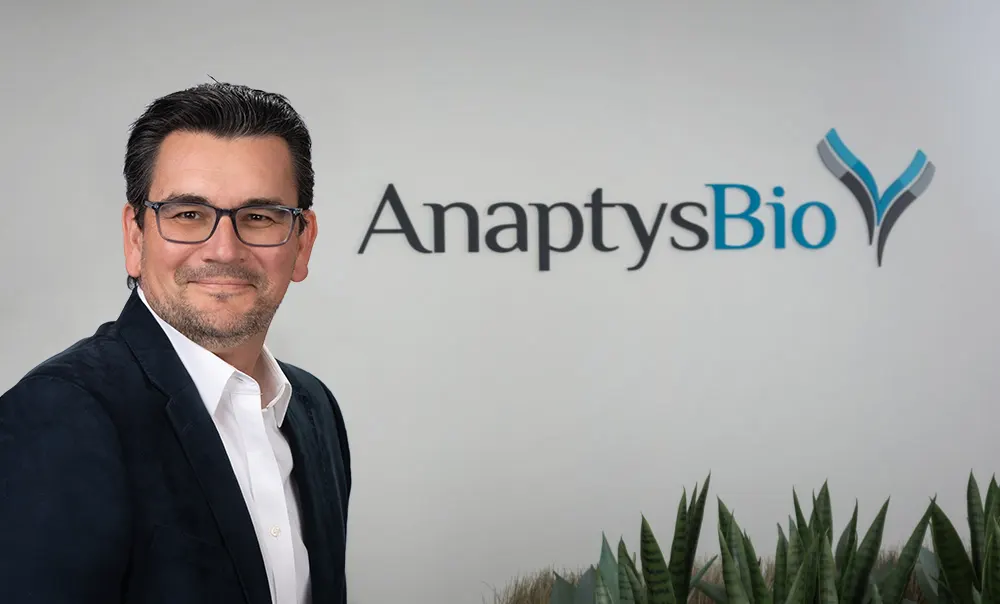AnaptysBio is developing ANB032, an investigational B and T lymphocyte attenuator (BTLA) receptor agonist, for the treatment of atopic dermatitis (AD). The Company recently presented preclinical data at the American Academy of Dermatology’s (AAD) annual meeting in San Diego, CA.
Paul Lizzul, MD, PhD, Chief Medical Officer of AnaptysBio, spoke with the Dermatology Digest about the study findings, its implications, and what’s next for this novel therapeutic.
TDD: Can you tell us about the BTLA receptor and why it appears to be a viable target in AD?
Paul Lizzul, MD, PhD: “Our immune system is an intricate web of checks and balances meant to detect, identify, and eliminate potential threats and pathogens while at the same time avoiding mounting an abnormal maladaptive response to ourselves (eg, autoimmune disease). Essential in this process are extracellular receptors, called checkpoint receptors, which serve as both markers and regulators of immune cell activation, deactivation, and overall function. They help regulate and modulate the immune systems’ responses. Research suggests that for people living with autoimmune and inflammatory diseases, such as AD, rheumatoid arthritis, or ulcerative colitis, their immune system is not able to properly turn down runaway inflammatory cell activation and proliferation. Targeting these central node checkpoints with an agonist antibody leverages the immune systems’ natural built-in regulatory mechanisms to modulate/dampen or ‘hit the brakes’ on runaway inflammation, and thereby bring the system back into balance so that their disease doesn’t continue along its vicious unregulated cycle. The BTLA receptor is one such key receptor. BTLA is expressed predominately on activated immune cells, including T-cells, B-cells, and dendritic cells (DCs) that drive inflammatory and autoimmune diseases. ANB032 is a novel, non-depleting IgG4 antibody that binds to the BTLA checkpoint receptor on immune cells, thereby engaging the cell’s natural regulatory machinery to reduce activated T-cell proliferation, reduce inflammatory cytokine secretion, and modulate DC function, including the subsequent induction of regulatory T-cells (Tregs). In addition, by interacting in the periphery (blood), ANB032 prevents further migration of inflammatory pathogenic T cells into the inflamed target tissue (eg, skin, joint, gut). ANB032’s broad but targeted cellular reach holds promise for the treatment of many systemic inflammatory and autoimmune diseases where the natural immune response is dysregulated and hyperactivated, including in dermatology.”
TDD: Why AD, specifically?
Dr. Lizzul: “AnaptysBio is currently studying ANB032 in AD. AD is a heterogenous disease where multiple immune cells (and their associated cytokines), including Th1, Th2, Th17, Th22, and also DCs, contribute significantly to disease pathogenesis. This biology driving AD pathogenesis matches well with the mechanism of action of ANB032. Phase 1 data in healthy patients was previously presented.”
TDD: What did the study presented at AAD add to the literature?
Dr. Lizzul: “Previous research has shown that AD is a systemic disease rather than localized only to the skin and is driven by the involvement of broad T cell activity, cytokines, and DCs. Knowing this, we wanted to research the potential of ANB032 not only to impact inflammatory T cells but also to modulate DC maturation and function. DCs are considered the upstream orchestrators (or the Generals) of T cell activation. They largely exist in two states – immature and mature, and we know that mature DCs act earlier in the inflammatory cycle to educate and stimulate naïve T cells and turn them into activated T cells. Therefore, in this preclinical study, we stimulated DCs with lipopolysaccharide (LPS) to activate/mature them in the presence of ANB032 or a control non-active isotype antibody. Data show BTLA is more highly expressed on mature DCs. LPS stimulation of DCs induced an increase in the number of mature DCs, and this was reduced by ANB032. ANB032 also reduced molecules that are responsible for antigen presentation (MHC-II) and co-stimulatory molecule expression (CD40, CD80, CD86) on DCs. Additionally, ANB032-treated DCs were evaluated in a mixed-lymphocyte reaction, where they generated significantly more functional Tregs that contributed to reducing the inflammatory cytokines interferon-gamma (IFNγ), interleukin IL-5 and IL-13, all cytokines that contribute to the pathogenesis of AD. Tregs express the transcription factor Foxp3 and can suppress the activation, proliferation, and cytokine production of CD4+ and CD8+ T cells, thereby playing a critical part in modulating and balancing our immune system. This is a multifaceted, unique, and potentially highly potent yet targeted mechanism through which ANB032 may contribute to the modulation and resolution of inflammation, resulting in durable responses and the restoration of immune balance in numerous inflammatory and autoimmune diseases. We believe this ability to leverage and harness the natural endogenous regulatory mechanisms found in all of us could be a key driver of differentiated outcomes for ANB032 in AD.”
TDD: What are the next steps with ANB032?
Dr. Lizzul: “Anaptys is currently enrolling patients in a robust global, Phase 2b study of ANB032 in moderate-to-severe AD, with top-line data anticipated by the end of 2024. We look forward to continuing our research and pursuing safe and effective treatments that can result in durable responses, and restore immune balance for patients suffering from heterogenous and life-changing diseases such as AD.”


